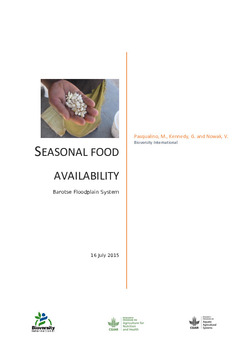Seasonal food availability: Barotse floodplain system

Citation
Pasqualino, M.; Kennedy, G.; Nowak, V. (2015). Seasonal food availability: Barotse floodplain system. CGIAR Research Program on Aquatic Agricultural Systems. Biodiversity International, Italy
The CGIAR Research Program on Aquatic Agricultural Systems (AAS) is being implemented in ten communities in the Barotse floodplain in Zambia's Western Province. The objective of the AAS program is to reduce poverty and improve food security by harnessing the potential, productivity and diversity of aquatic and agricultural systems. Within the Barotse floodplain, the program aims to improve the productivity and diversification of aquatic agricultural management practices in order to make better use of seasonal flooding patterns and natural resources and improve the livelihoods of the poor and vulnerable. An understanding of the food and nutrition security situation in the Barotse floodplain is essential to supporting the AAS program objective. Food availability in the Barotse is highly seasonal and is especially limited during the hunger season, which lasts from August or September to January. During this time, as food shortages increase, food and nutrition insecurity become more severe.3 Exploring the links between biodiversity and diet diversity within the floodplain allows the identification of entry points for sustainable and diverse diet options. Participatory action research (PAR) was therefore conducted between 2014 and 2015 in the ten AAS communities to identify the available food items within the communities and observe patterns in temporal changes of food availability. This narrative provides an explanation of how that research has been conceptualized/envisaged in the form of one all-inclusive seasonal food availability calendar of the AAS Barotse floodplain communities, and discusses trends in food availability across the communities.
Permalink
Date Available
Type
Publisher
Countries
Copyright
CC BY 4.0
Topics